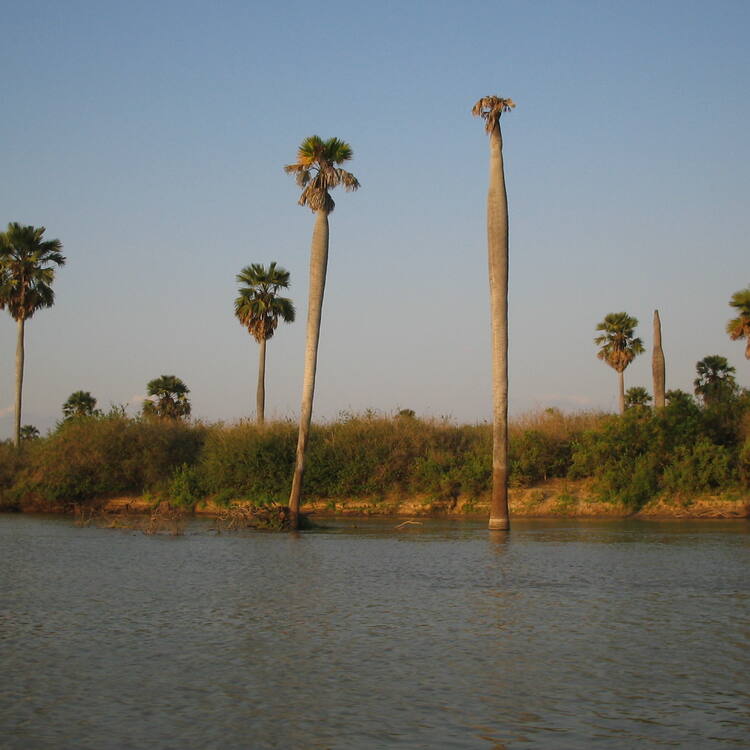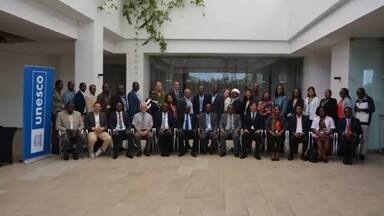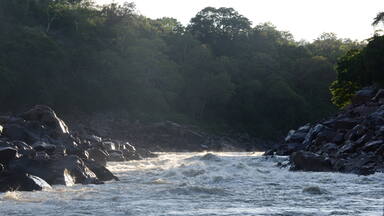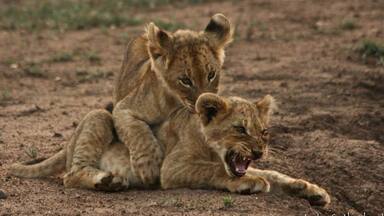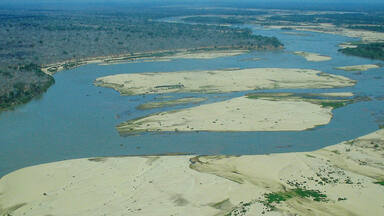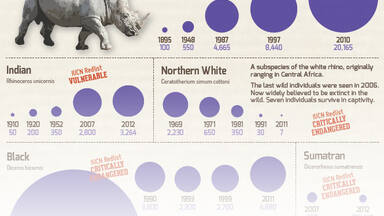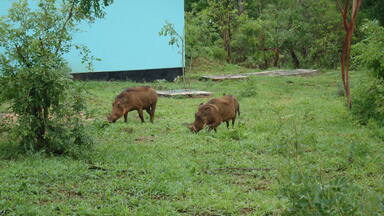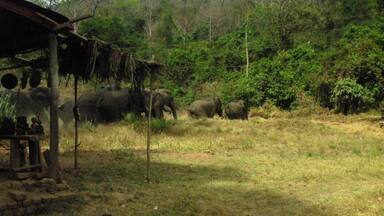Selous Game Reserve
Selous Game Reserve
Large numbers of elephants, black rhinoceroses, cheetahs, giraffes, hippopotamuses and crocodiles live in this immense sanctuary, which measures 50,000 km2 and is relatively undisturbed by human impact. The park has a variety of vegetation zones, ranging from dense thickets to open wooded grasslands.
Description is available under license CC-BY-SA IGO 3.0
Réserve de gibier de Selous
Éléphants, rhinocéros noirs, guépards, girafes, hippopotames et crocodiles vivent en très grand nombre dans cet immense sanctuaire de 50 000 km2 demeuré à peu près à l'abri de l'homme. Le parc comprend des zones de végétation variées, depuis les fourrés denses jusqu'à des prairies boisées bien dégagées.
Description is available under license CC-BY-SA IGO 3.0
محمية سيلوس للطرائد
يعيش في هذا الملاذ الشاسع عدد كبير من الفيلة ووحيد القرن الأسود وفهد الغيبار والزرافات وأفراس النهر والتماسيح. وتمتد المحمية على مسافة 50000 كيلومتر مربع بمنأى عن يد الإنسان وتحوي نباتات متنوعة بدءاً بالأدغال الكثيفة وصولاً الى المروج المشجرة السالكة.
source: UNESCO/CPE
Description is available under license CC-BY-SA IGO 3.0
塞卢斯禁猎区
塞卢斯禁猎区占地5万平方公里,在这个很少受人类干扰的广大原野里生活着数量众多的大象、黑犀牛、印度豹、长颈鹿、河马以及鳄鱼。这个公园的植被种类众多,既有浓密的灌木丛,又有树木茂盛的广阔草原。
source: UNESCO/CPE
Description is available under license CC-BY-SA IGO 3.0
Охотничий резерват Селус
Большое число слонов, черных носорогов, гепардов, жирафов, бегемотов и крокодилов обитают на этой охраняемой территории с почти не измененной человеком природой (площадь резервата 4,5 млн. га). В парке встречается разнообразная растительность – от густых лесов до открытых саванн.
source: UNESCO/CPE
Description is available under license CC-BY-SA IGO 3.0
Reserva de caza de Selous
En este inmenso santuario de 50.000 km2, relativamente poco alterado por la presencia del hombre, vive un gran número de elefantes, rinocerontes negros, onzas, jirafas, hipopótamos y cocodrilos. El parque comprende zonas de vegetación muy variadas, desde matorrales densos hasta praderas boscosas abiertas.
source: UNESCO/CPE
Description is available under license CC-BY-SA IGO 3.0
セルー・ゲーム・リザーブ
source: NFUAJ
Selous wildreservaat
Dit reservaat van 50.000 vierkante kilometer is een van de grootste beschermde gebieden in Afrika. Het reservaat heeft een uitzonderlijk hoge variëteit aan habitats waaronder Miombo-bossen, open graslanden, rivieren en moerassen. In het bosgebied komen meer dan 2.100 planten voor. Verder beschermt dit gebied een indrukwekkend aantal zoogdieren, waaronder de Afrikaanse olifant (106.300) ,de zwarte neushoorn (2135) en wilde jachthonden. Daarnaast leven er grote aantallen jachtluipaarden, giraffen, nijlpaarden en krokodillen. Door zijn enorme omvang blijven de ecologische en biologische processen relatief ongestoord. Dit wordt versterkt doordat het reservaat is ingebed in een ecosysteem van 90.000 vierkante kilometer, bestaand uit nationale parken, bosreservaten en gemeenschappelijke natuurgebieden.
Source: unesco.nl
Outstanding Universal Value
Brief synthesis
The Selous Game Reserve, covering 50,000 square kilometres, is amongst the largest protected areas in Africa and is relatively undisturbed by human impact. The property harbours one of the most significant concentrations of elephant, black rhinoceros, cheetah, giraffe, hippopotamus and crocodile, amongst many other species. The reserve also has an exceptionally high variety of habitats including Miombo woodlands, open grasslands, riverine forests and swamps, making it a valuable laboratory for on-going ecological and biological processes.
Criterion (ix): The Selous Game Reserve is one of the largest remaining wilderness areas in Africa, with relatively undisturbed ecological and biological processes, including a diverse range of wildlife with significant predator/prey relationships. The property contains a great diversity of vegetation types, including rocky acacia-clad hills, gallery and ground water forests, swamps and lowland rain forest. The dominant vegetation of the reserve is deciduous Miombo woodlands and the property constitutes a globally important example of this vegetation type. Because of this fire-climax vegetation, soils are subject to erosion when there are heavy rains. The result is a network of normally dry rivers of sand that become raging torrents during the rains; these sand rivers are one of the most unique features of the Selous landscape. Large parts of the wooded grasslands of the northern Selous are seasonally flooded by the rising water of the Rufiji River, creating a very dynamic ecosystem.
Criterion (x): The reserve has a higher density and diversity of species than any other Miombo woodland area: more than 2,100 plants have been recorded and more are thought to exist in the remote forests in the south. Similarly, the property protects an impressive large mammal fauna; it contains globally significant populations of African elephant (Loxodontha africana) (106,300), black rhinoceros (Diceros bicornis) (2,135) and wild hunting dog (Lycaon pictus). It also includes one of the world's largest known populations of hippopotamus (Hippopotamus amphibius) (18,200) and buffalo (Syncerus caffer) (204,015). There are also important populations of ungulates including sable antelope (Hippotragus niger) (7000), Lichtenstein's hartebeest (Alcelaphus lichtensteinii) (52,150), greater kudu (Tragelaphus strepsiceros), eland (Taurotragus oryx) and Nyassa wildebeest (Connochaetes albojubatus) (80,815). In addition, there is also a large number of Nile crocodile (Crocodilus niloticus) and 350 species of birds, including the endemic Udzungwa forest partridge (Xenoperdix udzungwensis) and the rufous winged sunbird (Nectarinia rufipennis). Because of this high density and diversity of species, the Selous Game Reserve is a natural habitat of outstanding importance for in-situ conservation of biological diversity.
Integrity
With its vast size (5,120,000 ha), the Selous Game Reserve retains relatively undisturbed on-going ecological and biological processes which sustain a wide variety of species and habitats. The integrity of the property is further enhanced by the fact that the Reserve is embedded within a larger 90,000 km2 Selous Ecosystem, which includes national parks, forest reserves and community managed wildlife areas. In addition the Selous Game Reserve is functionally linked with the 42,000 km2 Niassa Game Reserve in Mozambique, and this is another important factor that ensures its integrity. With no permanent habitation inside its boundaries, human disturbance is low.
Protection and management requirements
The Selous Game Reserve has appropriate legal protection and a management plan has been developed. It is managed as a game reserve, with a small area (8%) in the north dedicated to photographic tourism while most of the property is managed as a hunting reserve. As long as quota are established and controlled in a scientific manner, the level of off-take should not impact wildlife populations and, in fact, should generate substantial income which needs to be made available for the management of the reserve in order for the system to be sustainable. A detailed tourism strategy for the reserve needs to be developed, in line with the framework and principles outlined in the management plan. The income generated by those activities needs to be made available for the management of the reserve in order for the system to be sustainable. The large size of the reserve presents important management challenges in terms of the levels of staffing and budget required. Key management issues that need to be addressed are: control of poaching, in particular of elephants and black rhinoceros; ensuring sufficient benefits for the local communities through the wildlife management areas and the improved management of hunting and photographic tourism. Enhanced surveillance and ecological monitoring systems are required to provide a better scientific/technical basis for management of the property's natural resources, as well as to better understand the impacts/benefits of consumptive and non-consumptive tourism. The most significant threats are related to exploration and extraction of minerals, oil and gas, and large infrastructure plans; environmental impact assessments need to be conducted for all development activities in the vicinity of the property that are likely to have an impact of the property's Outstanding Universal Value. To ensure long term integrity of the property it is important to ensure its management as part of a wider Selous ecosystem and to take the necessary measures to maintain the functional link to Niassa Game Reserve in Mozambique.
